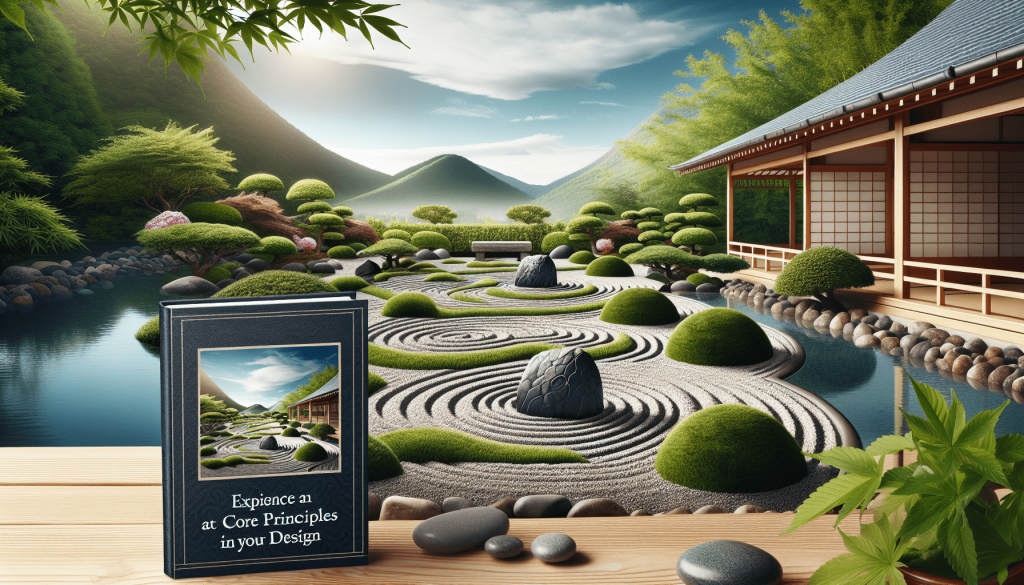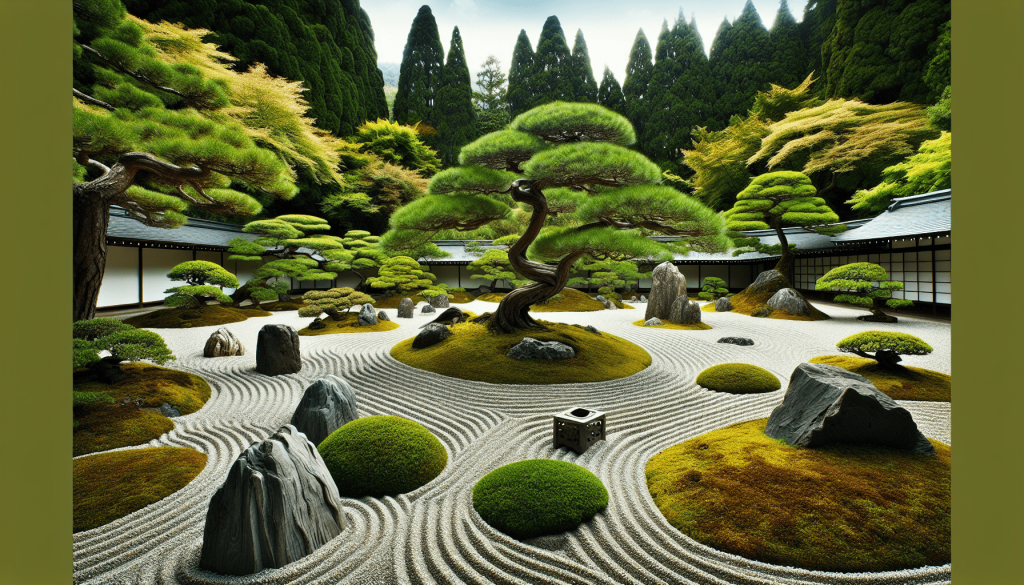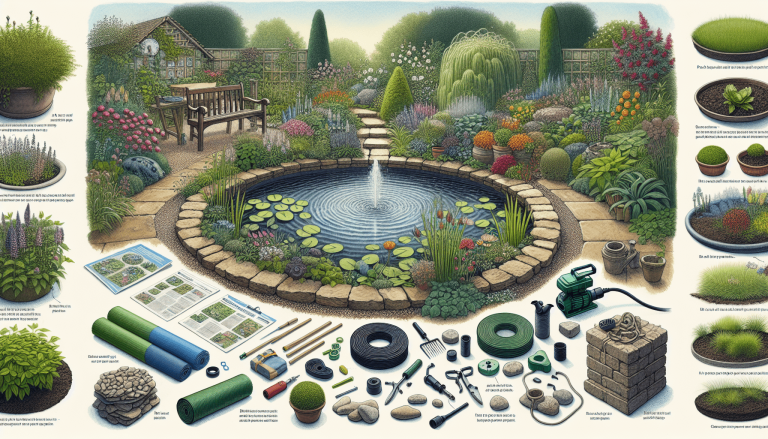Imagine stepping into a tranquil oasis where the worries of the world melt away, replaced by the gentle rustle of bamboo and the soothing flow of water. Creating a garden with a Japanese Zen garden aesthetic allows you to bring this sense of peace and serenity into your own outdoor space. By incorporating elements like carefully placed rocks, zen symbolism, and meticulously pruned plants, you can create a haven that reflects the harmonious beauty of nature and provides a sanctuary for relaxation and contemplation. In this article, we will explore the essential elements and guiding principles of a Japanese Zen garden aesthetic, empowering you to bring a touch of tranquility to your own backyard.
Table of Contents
ToggleChoosing the Right Location
Consider the size of your garden
When creating a Japanese Zen garden, the size of your garden is an important factor to consider. Japanese gardens are typically designed to be in harmony with the surrounding natural environment, so it’s crucial to choose a location that allows for the proper size and scale of elements within the garden.
Assess sunlight and shade patterns
Sunlight and shade patterns play a significant role in the overall health and vitality of your garden. Take note of how the sun moves across your garden throughout the day and which areas receive direct sunlight versus shade. This information will help you determine which plants will thrive in specific areas and guide your design choices.
Check for proper drainage
Proper drainage is essential in any garden, including a Japanese Zen garden. Excessive moisture can lead to the growth of mold, fungi, and other unwanted problems. Ensure that your garden has adequate drainage to prevent waterlogged soil and create a healthy environment for your plants to thrive.
Designing the Layout
Research traditional Japanese garden designs
Before embarking on your Japanese Zen garden journey, it’s essential to familiarize yourself with traditional Japanese garden designs. Research different styles such as the dry rock garden (karesansui), tea gardens (roji), and stroll gardens (kaiyū-shiki). Understanding these designs will help you select the most appropriate layout for your garden.
Create distinct areas within the garden
A Japanese Zen garden typically consists of distinct areas that serve different purposes. Consider incorporating designated areas for meditation, tea ceremonies, or simply for sitting and enjoying the tranquil atmosphere. By creating distinct spaces, you can enhance the overall experience and functionality of your garden.
Incorporate natural elements like rocks and water
Nature is at the heart of Japanese Zen gardens, and incorporating natural elements like rocks and water is crucial to achieving an authentic aesthetic. Rocks, in particular, represent mountains and can be strategically placed to create a sense of depth and visual interest. Water elements, such as ponds or streams, symbolize the harmonious flow of nature and provide a soothing ambiance.
Selecting Plants and Trees
Focus on evergreen plants
In Japanese Zen gardens, evergreen plants are commonly preferred due to their ability to maintain color and foliage throughout the year. Plants like Japanese maple (Acer palmatum), bamboo, and pine trees (Pinus spp.) are popular choices for their year-round appeal and resilience.
Choose plants with simple and elegant forms
Simplicity and elegance are key characteristics of Japanese Zen gardens. Look for plant species with clean, minimalistic forms like ornamental grasses, ferns, and Japanese irises. These plants will contribute to the overall aesthetic of tranquility and simplicity.
Opt for native or adapted species
To ensure the long-term health and sustainability of your garden, consider selecting native or adapted plant species. Native plants are naturally well-suited to the local climate and will require less maintenance and water. However, if certain native plants are not available or suitable, choose adapted species that can thrive in your specific region.
Using Gravel and Sand
Use gravel to create pathways
Gravel is a staple in Japanese Zen gardens and is often used to create pathways that guide visitors through the garden. Choose a visually pleasing gravel color, such as warm earth tones, and create meandering paths to add a sense of movement and exploration to your garden.
Incorporate sand for a Zen rock garden
Sand is another important element in Japanese Zen gardens, particularly in the creation of rock gardens. The smooth texture of sand provides a calming effect and serves as a canvas for the placement of rocks and the raking of patterns. Use sand to mimic the natural flow of water or to represent waves in a Zen rock garden.
Rake the sand in wave or intricate patterns
Raking patterns in the sand is a meditative practice often associated with Japanese Zen gardens. Use a wooden rake or comb to create wave-like patterns or intricate designs, such as circles or spirals. The act of raking can help clear the mind and bring a sense of calm and tranquility to both the gardener and those who visit the garden.
Adding Water Elements
Install a small pond or water feature
Water is a central element in Japanese Zen gardens, representing purity and tranquility. Consider adding a small pond or water feature to create a peaceful focal point. The sound of flowing water can be incredibly soothing and adds an extra layer of sensory experience to your garden.
Integrate a bamboo water fountain
Bamboo water fountains, known as shishi-odoshi or “deer scarers,” are a popular addition to Japanese Zen gardens. These bamboo devices fill with water and, when tipped by the weight of the water, create a gentle knocking sound. The rhythmic sound adds an auditory element to the garden, enhancing its overall Zen atmosphere.
Use water basins or Tsukubai for purification rituals
Water basins, known as tsukubai, are commonly found in traditional Japanese gardens and serve as a symbolic cleansing area. Incorporating a tsukubai allows for purification rituals, such as the symbolic washing of hands and mouth before entering a tea house or meditation space. Adding a water element with these cultural significances can deepen the authenticity of your Zen garden.
Selecting Decorative Elements
Introduce lanterns or stone ornaments
Lanterns and stone ornaments are distinctive features of Japanese Zen gardens. Lanterns can serve as both functional lighting elements and decorative focal points. Stone ornaments, such as statues or pagodas, can add a sense of serenity and cultural richness to your garden. Choose pieces that complement the overall aesthetic and create a harmonious ambiance.
Place a simple wooden bench or teahouse
Providing seating areas within your Zen garden is essential for relaxation and contemplation. Consider placing a simple wooden bench or constructing a traditional teahouse. These spaces invite visitors to pause, reflect, and appreciate the beauty and tranquility of the surroundings.
Use decorative bamboo screens for privacy
Privacy can be essential in creating a serene and secluded atmosphere within your Japanese Zen garden. Decorative bamboo screens can offer both privacy and an additional natural element. These screens can be strategically placed to block unwanted views and create a sense of enclosure within your garden space.
Arranging Stones and Rocks
Choose different sizes and shapes of rocks
The arrangement of stones and rocks in a Japanese Zen garden is carefully considered. Select stones of varying sizes and shapes to create visual interest and mimic the natural landscape. Consider the symbolism behind each stone and how it contributes to the overall aesthetic and philosophy of your garden.
Position the rocks in a natural and asymmetrical way
Japanese Zen gardens follow the principles of asymmetry and naturalness. When arranging rocks, avoid overly symmetrical patterns and instead aim for a natural and organic composition. Experiment with different positions and orientations to create a pleasing balance that reflects the rhythm and flow of nature.
Consider the concept of Ma (negative space)
The concept of Ma, or negative space, is an essential aspect of Japanese aesthetics. It refers to the empty spaces between elements and is crucial in achieving a sense of balance and tranquility. Leave intentional gaps and open spaces between rocks and other elements to create a harmonious relationship between emptiness and decoration.
Incorporating Moss and Moss Gardens
Grow moss on rocks or in shady areas
Moss is a common element in Japanese Zen gardens and adds a lush, green texture to the landscape. It thrives in shaded and moist areas, making it ideal for growing on rocks or in areas with low sunlight. Introducing moss not only enhances the visual appeal but also reinforces the natural and organic atmosphere of your garden.
Create a dedicated moss garden
For a more immersive experience, consider creating a dedicated moss garden within your larger Zen garden. Lay a layer of nutrient-rich soil mixed with moss spores to encourage moss growth. With proper care, your moss garden will develop into a velvety carpet, adding a sense of tranquility and grounding to your space.
Ensure proper humidity and moisture levels for moss growth
To promote healthy moss growth, it’s important to monitor and maintain the proper humidity and moisture levels in your garden. Moss thrives in moist environments, but be careful not to oversaturate the soil. Regularly misting or light watering can help create an ideal environment for moss to flourish.
Maintaining a Neat and Simple Appearance
Regularly trim and prune plants for a clean look
Maintenance plays a crucial role in keeping your Japanese Zen garden looking neat and orderly. Regularly trim and prune plants to ensure a clean and well-maintained appearance. Remove any dead or overgrown foliage to promote healthy growth and maintain the overall simplicity and balance of the garden.
Keep pathways free of debris and fallen leaves
Pathways are an integral part of any garden, and keeping them clear of debris and fallen leaves is essential. Regular sweeping or raking will help maintain a clean and inviting pathway, creating a sense of order and ease of movement throughout the garden.
Maintain the balance between emptiness and decoration
Maintaining the balance between emptiness and decoration is crucial for the overall appearance of a Japanese Zen garden. Avoid overcrowding with excessive decorations and maintain a sense of simplicity and minimalism. Regularly assess and adjust the placement of elements to ensure harmony and balance within the space.
Embracing Zen Philosophy and Mindfulness
Understand the principles of Wabi-Sabi
Wabi-Sabi is a Japanese aesthetic philosophy that embraces imperfection, transience, and simplicity. It encourages finding beauty in the imperfect and appreciating the natural cycle of growth and decay. Embrace the principles of Wabi-Sabi in your Zen garden by celebrating the changing seasons, incorporating weathered elements, and allowing the passage of time to enhance the beauty of your space.
Practice mindfulness while tending to the garden
Gardening can be a meditative practice, and tending to your Japanese Zen garden provides an opportunity for mindfulness. Approach each task with intention, focus on the present moment, and immerse yourself in the sensory experience of gardening. Allow your garden to become a sanctuary for mindfulness and self-reflection.
Create a space for meditation and contemplation
A Japanese Zen garden is designed to provide a space for meditation and contemplation. Dedicate a specific area within your garden for this purpose, such as a small meditation platform or a designated seating spot. Surround this space with elements that inspire tranquility, such as gentle flowing water or a serene stone arrangement. Use this space to cultivate inner peace and to connect with yourself and the surrounding environment.
By following these guidelines and immersing yourself in the philosophy of Japanese Zen gardens, you can create a tranquil and harmonious outdoor space that promotes a sense of peace, reflection, and connection with nature. Embark on this journey of creating your own Japanese Zen garden and embrace the serenity and mindfulness it brings to your life.








